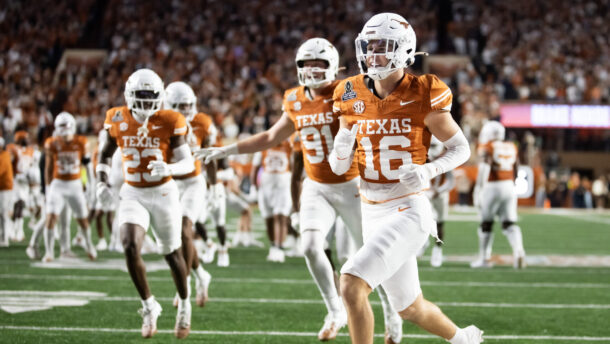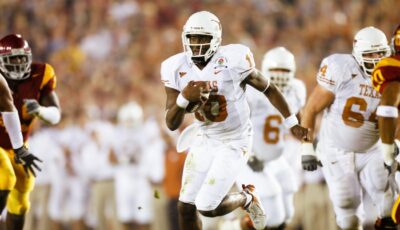
SEC Week 9 Primer: Auburn still controls its own fate. Can it derail LSU’s?
By Matt Hinton
Published:
Everything you need to know about this weekend’s SEC slate.
Game of the Week: Auburn at LSU (-10.5)
The stakes
We’re coming to the point in the season where vague gestures toward Playoff implications begin to narrow into more concrete scenarios. For LSU, a win would be its 3rd over a top 10 opponent and set up a blockbuster Game of the Century showdown with Alabama on Nov. 9 for true SEC West supremacy. For Auburn, a win would keep it in the thick of the race and divert a considerable portion of the looming Bama-LSU hype to the Iron Bowl.
At 6-1, Auburn obviously has more at stake Saturday: A 2nd SEC loss would relegate the Tigers to spoiler status in November, a role they’ve played far too often under Gus Malzahn for certain fans’ tastes. But a loss at this point would be a major blow to LSU’s goals, too. Strictly in terms of Playoff math, an L would cut the Tigers’ margin for error to zero – the Alabama game would become a literal must-win – and put Auburn in control of its fate in the standings. (Even if LSU won out, Auburn would own the head-to-head tiebreaker if both teams finish 11-1.) More fundamentally, it would deflate the heavy This Is Our Year vibes in Baton Rouge at the most deflating possible moment on the schedule.
And honestly, who outside of Auburn fans really wants to see that bubble popped? The season has been building to Bama-LSU as the ultimate test of whether the Tigers’ evolution into a up-tempo, spread-passing juggernaut has paid off after years of watching the Tide stop their hard-nosed approach cold. The prospect of a 1 vs. 2 shootout in Tuscaloosa that mirrors the 1 vs. 2 slugfest in 2011 is too good not to happen. So in one sense, at least, you could say Auburn has been relegated to the spoiler role already.
The stat: 5.4 points per possession
That’s LSU’s red-zone scoring rate, best in the SEC this season and No. 2 in the nation. For an attack that also leads the nation in red-zone possessions per game (5.6), that adds up to a lot of points.
In fact, for all of their big-play prowess, a huge share of the Tigers’ prolific output on the scoreboard hinges on their efficiency inside the 20-yard line. They’ve reached the red zone on nearly 43 percent of their total offensive possessions, one of the highest rates in the country; from there, they’re 1 of just 3 teams (along with Iowa and Notre Dame) that have scored on 100 percent of red-zone trips. That includes 31 of their 45 offensive touchdowns (the most of any team) and 18 of Joe Burrow’s 29 TD passes (the most of any quarterback). No other offense has been better at creating those opportunities or finishing them.
For its part, Auburn’s defense has been solid at limiting red-zone trips, allowing fewer than 3 per game, and especially at limiting scoring on those trips, yielding just 3.3 points per possession; that’s good for 10th nationally. Against SEC opponents, the Tigers have been even better, holding Texas A&M, Mississippi State, Florida, and Arkansas to 4 touchdown on 11 trips. The season-opening win over Oregon was fueled in part by a pair of early red-zone stops that kept the Ducks from putting the game away before halftime. (Then again, Auburn returned the favor by coming up empty on 2 of its 5 red-zone trips against the Ducks and settling for a field goal on another.) LSU is going to move the ball, but in a competitive game where even possession matters even one stop can tip the balance.
The big question: Can Bo Nix handle Death Valley?
Gus Malzahn rolled the dice in August on a talented but unpredictable true freshman quarterback, and over the first half of the season Nix has turned out to be … a talented but unpredictable true freshman quarterback.
His performance has spanned the good (16-of-21, 335 yards, 2 TDs in a blowout win over Mississippi State), the wild (2 INTs followed 2 clutch TDs in an erratic, come-from-behind win over Oregon), the meh (12-of-20, 100 yards, 1 TD in a defensively driven win at Texas A&M), and the ugly (11-of-27, 145 yards, 1 TD, 3 INTs in a sobering loss at Florida). In his first true road trip, to College Station, he looked like a seasoned vet, largely unfazed by the 12th Man. In his second, to Gainesville, he looked like a rookie, frequently overwhelmed by The Swamp.
Florida forces the Nix pick! pic.twitter.com/4UawXnTj82
— CBS Sports (@CBSSports) October 5, 2019
Not coincidentally, the loss at Florida marked Auburn’s worst rushing output of the year, by far, forcing Nix to pick up the slack for a ground game that failed to move the sticks at all until late in the 3rd quarter. After an open date, last week’s 51-10 win at Arkansas was an encouraging rebound on both fronts: The Tigers racked up 309 yards rushing on 6.7 per carry (not including sacks) despite the absence of starting RB Boobie Whitlow, and Nix connected on 3 TD passes on just 17 attempts. The division doormat came along at exactly the right time for the offense and particularly its fledgling leader to get back on track; how much of his restored confidence will translate to one of the most hostile environments in sports is anyone’s guess.
The verdict
LSU’s passing game has emerged very quickly as a unique challenge for any defense. But Auburn’s defensive front poses a unique challenge in its own right: On paper, Auburn’s run defense (which ranks 9th nationally vs. FBS opponents) vs. LSU’s rushing offense (which ranks 64th) is its biggest advantage. Personnel-wise, Marlon Davidson, Derrick Brown and Co. is the deepest pass-rushing rotation LSU has faced, one perfectly capable of forcing Burrow into uncharacteristically bad habits if they feel free to tee off on obvious passing downs.
If we’ve learned anything about the new and improved LSU offense, though, it’s concepts like “passing downs” and “run to set up the pass” are obsolete.
As I pointed out in last week’s primer, Burrow is the most prolific passer in the nation on 1st down, both in quality and quantity — every down is a passing down, especially in a system so heavily invested in RPOs. Auburn’s secondary is no more likely to successfully man up against LSU’s NFL-ready wideouts than Florida’s; if anything, it’s a slight step down. Meanwhile, LSU will benefit from the return of Terrace Marshall Jr. from a month-long absence. Unless Auburn’s front consistently dominates on a 1-on-1 basis, the results on the back end figure to be more of the same.
LSU 36, Auburn 23
Arkansas (+31.5) at Alabama
Uncharted waters for Bama: With Tua Tagovailoa on ice, sophomore Mac Jones will be the 1st backup QB to start a game due to injury in the Nick Saban era. Against any other SEC West rival, that might be cause for minor alarm or major panic, depending on the rival; against the Razorbacks, it’s more like an inconvenience. The point spread has moved from -33 on Sunday, when Alabama confirmed Tua’s absence, to -31.5 as of midweek.
Assuming Saban isn’t interested in testing Jones’ grasp of the finer points of the offense, the game plan likely calls for a heavy dose of Najee Harris, who has logged career-highs for touches each of the past 2 weeks against Texas A&M (23 for 133 yards) and Tennessee (25 for 153 yards) and could very well make it 3 in a row if the Tide revert to the Derrick Henry playbook. According to Pro Football Focus, Harris quietly leads all FBS backs with at least 80 carries this season in rushing conversion rate, having generated a first down or touchdown on 39 of his 95 attempts (41.0 percent).
Alabama 40, Arkansas 13
Mississippi State (+10.5) at Texas A&M
Say what you will about how much Jimbo Fisher is getting paid to post a 4-3 record, at least no one is floating rumors about him potentially jumping ship for Rutgers. The fact that Joe Moorhead even had to acknowledge the question midway through Year 2 in Starkville pretty much sums up the mood there: Mississippi State has lost 4 of its past 5, the past 3 by double digits, and is more than a month removed from scoring a touchdown in a game it didn’t already trail by at least 2 scores. A 4th consecutive loss in College Station would put the Bulldogs on the bubble for bowl eligibility.
Of course, if the Aggies aren’t in danger missing a bowl game, they’re not exactly lighting up scoreboards, either — especially coming off a sloppy 24-17 win at Ole Miss in which a defensive touchdown proved to be the difference. Kellen Mond needs more from an anemic ground game; A&M ranks dead last in the SEC in rushing offense vs. FBS opponents, and that’s with Mond himself as the leading rusher in those games. That might not matter this weekend if MSU continues to struggle to put points on the board, but much tougher tests await down the stretch.
Texas A&M 27, Mississippi State 20
Missouri (-10.5) at Kentucky
Missouri has gone on the road twice already this year as a double-digit favorite and lost both times, inexplicably going down in flames at Wyoming in the season opener and Vanderbilt last week on opposite ends of a 5-game home winning streak. The point spread in this one says less about oddsmakers trust the Tigers away from Columbia than it does about an even shakier state of affairs in Kentucky: The Wildcats remain unsettled behind center and have yet to score more than 21 points in a conference game. If Mizzou struggles again the home/road split will be officially a thing.
Missouri 31, Kentucky 17
South Carolina (-4) at Tennessee
Tennessee QB Brian Maurer is unlikely to play Saturday after being knocked out of a game for the 3rd time in as many weeks in the Vols’ loss at Alabama; it’s the 2nd consecutive week that he’s dealing with a concussion. That leaves either Jarrett Guarantano, whom coaches may not trust at this point, or redshirt freshman J.T. Shrout, who has barely played. The way the rest of South Carolina’s schedule shakes out — with winnable games against Vanderbilt and Appalachian State on deck, followed by a pair of likely losses to Texas A&M and Clemson to close the regular season — this is a must-win for the 3-4 Gamecocks’ chances of getting to 6.
South Carolina 26, Tennessee 18
Scoreboard
Week 8 record: 6-1 straight-up / 5-2 vs. spread
Season record: 55-13 straight-up / 34-34 vs. spread
Matt Hinton, author of 'Monday Down South' and our resident QB guru, has previously written for Dr. Saturday, CBS and Grantland.







